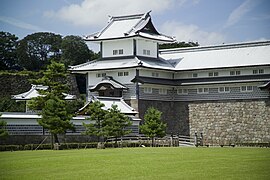Kanazawa Castle
| Kanazawa Castle | ||
|---|---|---|
|
View of the Ishikawa Gate |
||
| Creation time : | End of the 16th century | |
| Castle type : | Hirayamajiro (hill castle) | |
| Conservation status: | Partly preserved | |
| Place: | Kanazawa | |
| Geographical location | 36 ° 33 '51.5 " N , 136 ° 39' 33.2" E | |
|
|
||
The Kanazawa Castle ( Japanese 金沢城 , Kanazawa-jō ) in the city of Kanazawa ( Ishikawa Prefecture ) in Japan was the seat Maeda with its fief Kaga , she with over 1,000,000 koku income of the richest daimyo of the Edo period made.
history
Kanazawa Castle is at the end of a hill between the Saigawa and Asanogawa Rivers that extends northwest. Since 1546 the temple city Kanazawa Midō ( 金 沢 御堂 ), popularly called Oyama-gobō ( 尾 山 御 坊 ), was located there. It was during the Ikkō-Ikki been created by monks of the Buddhist faith Jōdo Shinshū related Ikko shū . In 1580 Shibata Katsuie succeeded in conquering the place and driving out the monks.
When after the Battle of Shizugatake in 1583 Maeda Toshiie ( 前 田 利 家 ; 1538–1599) received two additional counties in the north of the province of Kaga , he moved there from Komaruyama ( province of Noto ) and made the castle his residence. The Maeda resided in Kanazawa until the Meiji Restoration .
The attachment
The castle tower was built as early as 1586. In 1592 the moats Hasuike-bori (Hyakken-bori), Imori-bori, Hyakuchō-bori and the high wall in the south were expanded. In 1599 Takayama Ukon received the order from Toshiies son Toshinaga to create the trench Ōte-bori on the north side of the San-no-maru located Shin-maru and the inner Sōgamae-bori in front of the southwest side. In 1610 the outer Sōgamae-bori was also created.
The castle tower, which was burned down by lightning in 1602, was not replaced, a three-story watchtower served as a replacement. In 1620 the residence in the main castle and in 1631 the residence in Ni-no-maru was lost by fire. The Tatsumi Canal was then laid out for fire protection. It carries sufficient water over the ridge to the castle. From then on, the Ni-no-maru housed the residence and administration of the domain. In 1759 and 1808 the castle was again ravaged by fires.
After the Meiji Restoration, in 1872 the castle grounds came under the administration of the army, for which it served as the administrative seat. After 1945 the University of Kanazawa first used the site, after moving it came to the city, which converted it into a park.
The “Ishikawa Gate” and the “Thirty-fathom Longhouse” ( 三十 間 長 屋 ), both registered as important cultural assets , have been preserved from the castle . In 2001, the fifty-fathom longhouse, the Hishi watchtower, the Hashizume gate, the Tsuzuki watchtower and the Uchi-bori were restored in Ni-no-maru. In addition, the restoration of the Kahoku Gate and the Tatsumi Watchtower is being examined.
photos
Remarks
- ↑ Tatsumi ( 辰 巳 ) means southeast.
- ↑ At the same time, the canal is used to supply the Maeda park in front of the castle, the Kenroku-en , with water.
literature
- Ikeda, Kōichi: Kanazawa-jo in: Miura, Masayuki (Ed.): Shiro to jinya . Tokoku-hen. Gakken, 2006. ISBN 978-4-05-604378-5 .
- McClain, James L .: Kanazawa. A Seventeenth-Century Japaneses Castle Town . Yale University Press, 1982. ISBN 0-300-02736-2 .






